初中被动语态详细讲解.
初中英语被动语态讲解
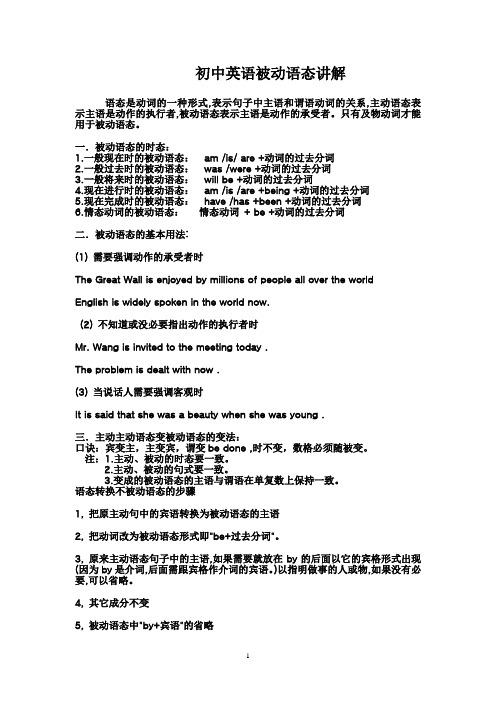
初中英语被动语态讲解语态是动词的一种形式,表示句子中主语和谓语动词的关系,主动语态表示主语是动作的执行者,被动语态表示主语是动作的承受者。
只有及物动词才能用于被动语态。
一.被动语态的时态:1.一般现在时的被动语态:am /is/ are +动词的过去分词2.一般过去时的被动语态:was /were +动词的过去分词3.一般将来时的被动语态:will be +动词的过去分词4.现在进行时的被动语态:am /is /are +being +动词的过去分词5.现在完成时的被动语态:have /has +been +动词的过去分词6.情态动词的被动语态:情态动词+ be +动词的过去分词二.被动语态的基本用法:(1) 需要强调动作的承受者时The Great Wall is enjoyed by millions of people all over the worldEnglish is widely spoken in the world now.(2) 不知道或没必要指出动作的执行者时Mr. Wang is invited to the meeting today .The problem is dealt with now .(3) 当说话人需要强调客观时It is said that she was a beauty when she was young .三.主动主动语态变被动语态的变法:口诀:宾变主,主变宾,谓变be done ,时不变,数格必须随被变。
注:1.主动、被动的时态要一致。
2.主动、被动的句式要一致。
3.变成的被动语态的主语与谓语在单复数上保持一致。
语态转换不被动语态的步骤1, 把原主动句中的宾语转换为被动语态的主语2, 把动词改为被动语态形式即"be+过去分词"。
3, 原来主动语态句子中的主语,如果需要就放在by的后面以它的宾格形式出现(因为by是介词,后面需跟宾格作介词的宾语。
初中中的被动语态用法详解
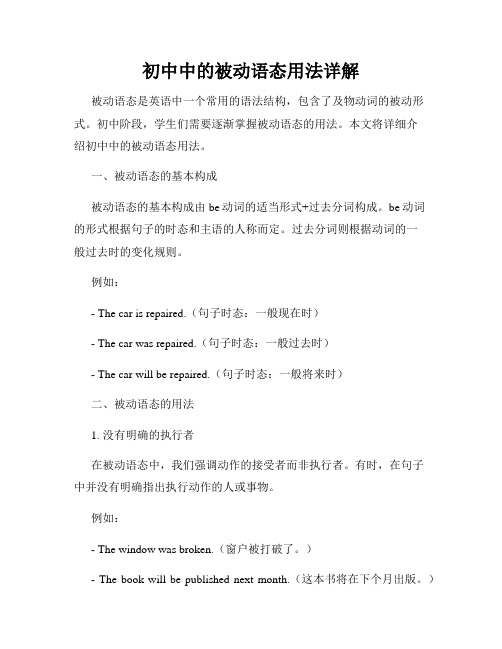
初中中的被动语态用法详解被动语态是英语中一个常用的语法结构,包含了及物动词的被动形式。
初中阶段,学生们需要逐渐掌握被动语态的用法。
本文将详细介绍初中中的被动语态用法。
一、被动语态的基本构成被动语态的基本构成由be动词的适当形式+过去分词构成。
be动词的形式根据句子的时态和主语的人称而定。
过去分词则根据动词的一般过去时的变化规则。
例如:- The car is repaired.(句子时态:一般现在时)- The car was repaired.(句子时态:一般过去时)- The car will be repaired.(句子时态:一般将来时)二、被动语态的用法1. 没有明确的执行者在被动语态中,我们强调动作的接受者而非执行者。
有时,在句子中并没有明确指出执行动作的人或事物。
例如:- The window was broken.(窗户被打破了。
)- The book will be published next month.(这本书将在下个月出版。
)2. 隐藏执行者在某些情况下,句子中刻意隐藏了动作的执行者。
例如:- The cake was eaten.(蛋糕被吃了。
)3. 顺序执行之动作被动语态常用于描述一系列按照一定顺序执行的动作。
例如:- The eggs are washed, peeled, and then boiled.(鸡蛋洗净、剥皮,然后煮熟。
)4. 惯用表达被动语态在某些固定的表达方式中也得到了广泛使用。
例如:- The decision was made.(决定已经做出。
)- The question was answered.(问题已经回答。
)三、主动语态与被动语态的转换在主动语态与被动语态之间进行转换时,需注意以下几点:1. 意义的改变:动作的焦点转移到了接受者身上,原主语成为了新的宾语;2. 动词形式的变化:be动词的形式和动词的过去分词形式相关;3. 语态的时态保持一致:主动语态的时态与被动语态的时态保持一致。
初中英语知识归点纳总结——被动语态

初中英语知识归纳总结——被动语态被动语态(一)教学重点被动语态在英语中,须通过动词的某种形式来表明句子的主语是动作的执行者还是动作的承受者,前一种句子是主动句,后一种是被动句。
英语的动词有两种语态形式,即主动语态和被动语态。
如果主语是动作是执行者,谓语动词用主动语态。
如果主语是动作的对象,谓语动词用被动语态。
如:They build this school.They school is built by them.1、被动语态的构成“助动词+(及物动词的)过去分词”构成动词被动语态的形式。
助动词be有人称、数和时态的变化,其变化规则与be作为系动词的变化完全一样。
如:This kind of TV set is made in Guangzhou.(一般现在时)The thief was arrested.(一般过去时)A new road is being built outside my house.(现在进行时)The man was being questioned by the police.(过去进行时)Your wallet has been found.(现在完成时)By the time we got there. The work had been finished.(过去完成时)My sister would be taken care of by grandma.(过去将来时)Your watch will be repaired.(一般将来时)教学难点:在英语里,有一些动词是不及物动词,后面不能跟宾语,所以没有被动语态。
以下动词只有主动语态,没有被动语态。
appear, die, happen, fall, arrive.2、五种时态的被动语态举例①一般现在时A lot of books are kept in our school library.Radio is used in everyday life.②一般过去时A thief was caught last night.They were asked to speak at the meeting.③现在进行时A new library is being put up in their school now.The watch is being repaired.④一般将来时The class meeting will be held next Saturday afternoon.The thieves will be arrested.⑤现在完成时My bag has been stolen.Many stamps have been collected by me since last year.3、主动语态变被动语态①主动结构的宾语变为被动结构的主语。
初中英语语法——被动语态用法总结归纳

初中英语语法——被动语态用法总结归纳被动语态是英语语法中的重要部分,学好被动语态的用法可以帮助学生更准确地理解和使用英语。
下面是被动语态用法的详细总结归纳。
1.被动语态的构成:被动语态由“助动词be+过去分词”构成,根据时态的不同,助动词be的形式也会发生变化。
如:- 一般现在时:am/is/are + 过去分词- 一般过去时:was/were + 过去分词- 一般将来时:will be + 过去分词- 现在进行时:am/is/are being + 过去分词- 过去进行时:was/were being + 过去分词- 现在完成时:have/has been + 过去分词- 过去完成时:had been + 过去分词2.被动语态的用法:被动语态用来强调动作的承受者(主语)而不是执行者,并且常用于以下情景:2.1当我们不知道或不关心动作的执行者时。
例如:The cake was eaten.(蛋糕被吃了。
)2.2当动作的执行者已知,但我们要强调动作的承受者时。
例如:The house was built by my grandfather.(这座房子是我爷爷建的。
)2.3当我们要避免使用第一人称或第二人称时。
例如:Mistakes were made.(犯了错误。
)3.被动语态的注意事项:在使用被动语态时,需要注意以下几点:3.1表示动作的动词要用过去分词形式。
过去分词的形式有规律变化和不规律变化两种。
如:- 规律变化:原形 + ed,例如:played, watched, called- 不规律变化:需要记忆,例如:born, written, eaten3.2被动句的主语是动作的承受者,通常出现在句子的前面。
如:- 主动语态:I cooked dinner.(我做了晚饭。
)- 被动语态:Dinner was cooked by me.(晚饭是我做的。
)3.3 不及物动词不能构成被动语态。
不及物动词没有宾语,因此不能强调动作的承受者。
初中被动语态知识点归纳与总结
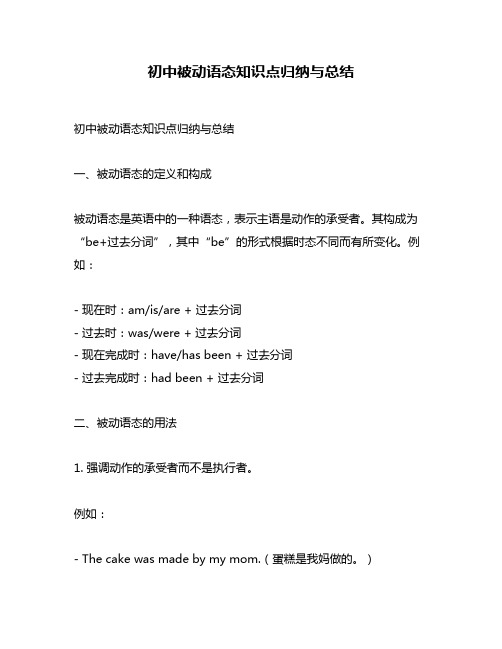
初中被动语态知识点归纳与总结初中被动语态知识点归纳与总结一、被动语态的定义和构成被动语态是英语中的一种语态,表示主语是动作的承受者。
其构成为“be+过去分词”,其中“be”的形式根据时态不同而有所变化。
例如:- 现在时:am/is/are + 过去分词- 过去时:was/were + 过去分词- 现在完成时:have/has been + 过去分词- 过去完成时:had been + 过去分词二、被动语态的用法1. 强调动作的承受者而不是执行者。
例如:- The cake was made by my mom.(蛋糕是我妈做的。
)2. 当执行者不确定或无需明确时。
例如:- The window was broken.(窗户破了。
)3. 当执行者已知但无需强调时。
例如:- The book was written by Mark Twain.(这本书是马克·吐温写的。
)4. 在科学、新闻报道等中常用被动语态。
例如:- The new drug has been tested on animals.(这种新药已经在动物身上进行了测试。
)三、被动语态与主动语态的转换1. 主动变被动:将主语改为宾语,动词变为过去分词,加上适当的助动词。
例如:- 主动:My mom made the cake.(我妈做了蛋糕。
)- 被动:The cake was made by my mom.(蛋糕是我妈做的。
)2. 被动变主动:将宾语改为主语,去掉助动词,将过去分词变为一般现在时。
例如:- 被动:The cake was made by my mom.(蛋糕是我妈做的。
)- 主动:My mom makes the cake.(我妈做蛋糕。
)四、被动语态的注意事项1. 被动语态只能用于及物动词。
例如:- 正确:The book was read by me.(这本书被我读了。
)- 错误:I was slept last night.(昨晚我被睡觉了。
初中英语知识点归纳被动语态
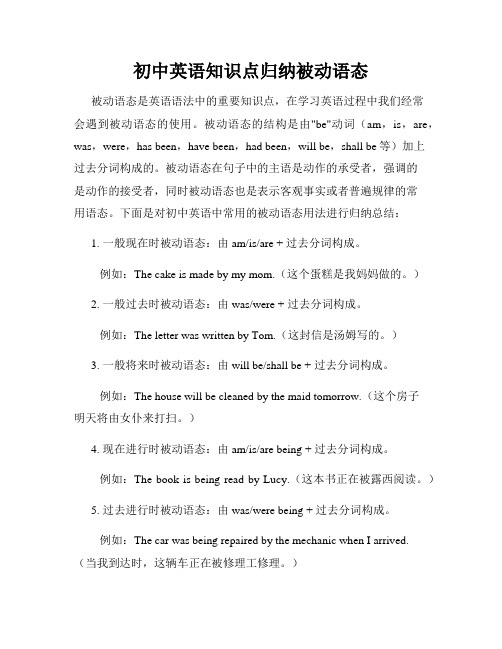
初中英语知识点归纳被动语态被动语态是英语语法中的重要知识点,在学习英语过程中我们经常会遇到被动语态的使用。
被动语态的结构是由"be"动词(am,is,are,was,were,has been,have been,had been,will be,shall be等)加上过去分词构成的。
被动语态在句子中的主语是动作的承受者,强调的是动作的接受者,同时被动语态也是表示客观事实或者普遍规律的常用语态。
下面是对初中英语中常用的被动语态用法进行归纳总结:1. 一般现在时被动语态:由am/is/are + 过去分词构成。
例如:The cake is made by my mom.(这个蛋糕是我妈妈做的。
)2. 一般过去时被动语态:由was/were + 过去分词构成。
例如:The letter was written by Tom.(这封信是汤姆写的。
)3. 一般将来时被动语态:由will be/shall be + 过去分词构成。
例如:The house will be cleaned by the maid tomorrow.(这个房子明天将由女仆来打扫。
)4. 现在进行时被动语态:由am/is/are being + 过去分词构成。
例如:The book is being read by Lucy.(这本书正在被露西阅读。
)5. 过去进行时被动语态:由was/were being + 过去分词构成。
例如:The car was being repaired by the mechanic when I arrived.(当我到达时,这辆车正在被修理工修理。
)6. 情态动词被动语态:由情态动词(can,could,may,might,must,should,would等)+ be + 过去分词构成。
例如:The film can be watched online.(这部电影可以在线观看。
(完整)初中英语被动语态讲解
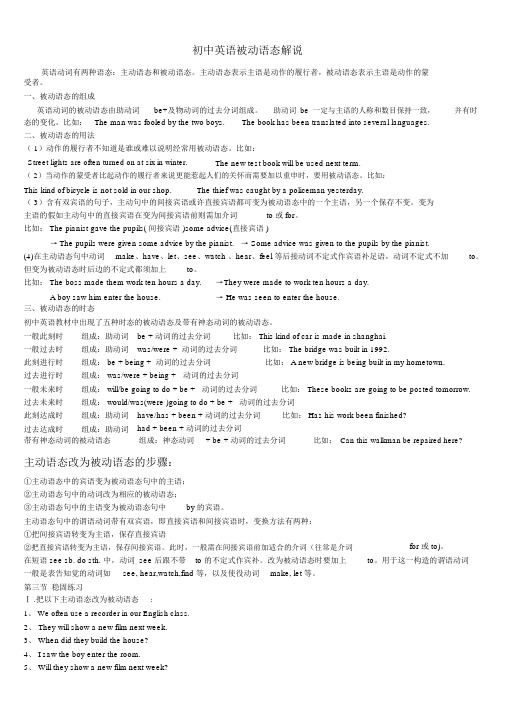
初中英语被动语态解说英语动词有两种语态:主动语态和被动语态。
主动语态表示主语是动作的履行者,被动语态表示主语是动作的蒙受者。
一、被动语态的组成英语动词的被动语态由助动词be+及物动词的过去分词组成。
助动词be一定与主语的人称和数目保持一致,态的变化。
比如:The man was fooled by the two boys.The book has been translated into several languages.二、被动语态的用法( 1)动作的履行者不知道是谁或难以说明经常用被动语态。
比如:并有时Street lights are often turned on at six in winter.The new test book will be used next term.( 2)当动作的蒙受者比起动作的履行者来说更能惹起人们的关怀而需要加以重申时,要用被动语态。
比如:This kind of bicycle is not sold in our shop.The thief was caught by a policeman yesterday.( 3)含有双宾语的句子,主动句中的间接宾语或许直接宾语都可变为被动语态中的一个主语,另一个保存不变。
变为主语的假如主动句中的直接宾语在变为间接宾语前则需加介词to 或 for。
比如: The pianist gave the pupils( 间接宾语 )some advice(直接宾语 )→The pupils were given some advice by the pianist. → Some advice was given to the pupils by the pianist.(4)在主动语态句中动词make、have、let、see、watch 、hear、feel 等后接动词不定式作宾语补足语,动词不定式不加to。
初中被动语态讲解

初中被动语态讲解一、什么是被动语态被动语态是英语中的一种句子结构,用来表达动作的接受者是动作的执行者。
在被动语态中,被动的动作承受者成为句子的主语,而动作的执行者则成为句子的宾语。
二、被动语态的构成被动语态的构成主要由“助动词be(包括am, is, are, was, were等) + 过去分词”组成。
例如:主动语态:Tom wrote a letter.被动语态:A letter was written by Tom.三、被动语态的用法1. 当我们不知道动作的执行者是谁或不重要时,可以使用被动语态。
例如:The cake was eaten.(这个蛋糕被吃了。
)2. 当我们希望强调动作的接受者时,可以使用被动语态。
例如:The new building was designed by a famous architect.(这座新建筑是由一位著名的建筑师设计的。
)3. 当我们希望避免重复使用动作的执行者时,可以使用被动语态。
例如:The car was repaired yesterday.(这辆车昨天被修好了。
)四、被动语态的时态被动语态的时态与主动语态的时态保持一致。
只需将助动词be的时态形式改为相应的时态即可。
例如:主动语态:She is writing a letter.被动语态:A letter is being written by her.五、被动语态的注意事项1. 直接宾语变为被动语态的主语,而主动语态的主语则变为被动语态的宾语。
例如:主动语态:They built a house.被动语态:A house was built by them.2. 当宾语为人称代词时,应将其改为宾格形式放在be之后。
例如:主动语态:She saw me.被动语态:I was seen by her.3. 当动词是不及物动词时,无法使用被动语态。
例如:主动语态:The bird flew away.被动语态:(错误)六、被动语态的练习题1. 主动语态:They will paint the room.被动语态:The room will be painted by them.2. 主动语态:She is cooking dinner.被动语态:Dinner is being cooked by her.3. 主动语态:He has finished the homework.被动语态:The homework has been finished by him.4. 主动语态:We are watching a movie.被动语态:A movie is being watched by us.5. 主动语态:They have invited him to the party.被动语态:He has been invited to the party by them.总结:被动语态是英语中常用的句子结构之一,通过将动作的接受者作为主语来强调动作的承受者。
- 1、下载文档前请自行甄别文档内容的完整性,平台不提供额外的编辑、内容补充、找答案等附加服务。
- 2、"仅部分预览"的文档,不可在线预览部分如存在完整性等问题,可反馈申请退款(可完整预览的文档不适用该条件!)。
- 3、如文档侵犯您的权益,请联系客服反馈,我们会尽快为您处理(人工客服工作时间:9:00-18:30)。
语法专练---被动语态一、语态概述我吃了一个苹果,那现在苹果怎样了?苹果被我吃了。
正如汉语中的被字句,英语中的“被字句”我们称之为被动语态。
英语中有两种语态:主动语态和被动语态。
英语的语态是通过动词形式的变化表现出来的。
主动语态表示主语是动作的执行者。
巧记为:主动、主动、主去动。
例如:Many people speak English.谓语:speak的动作是由主语many people来执行的。
被动语态表示主语是动作的承受者,即行为动作的对象。
巧记为:被动、被动、主被动。
例如:English is spoken by many people.主语English是动词speak的承受者。
例如:He opened the door.他开了门。
(主动句) The door was opened.门被开了。
(被动句)二、被动语态的构成被动语态由“be+及物动词的过去分词”构成。
不及物动词本身没有被动语态。
及物动词---本身意义不完整,后必须带宾语,有些还可以带双宾。
不及物动词---本身意义完整,不需要带宾语,如带宾语必须通过介词。
人称、数和时态的变化是通过be的变化表现出来的。
现以eat为例说明被动语态在各种时态中的构成。
一般现在时:am/is/are+eaten 一般过去时:was/were+eaten一般将来时:will/shall/be going to be+eaten 过去将来时:would/should/be going to be+eaten现在进行时:am/is/are being+eaten 过去进行时:was/were being+eaten现在完成时:have/has been+eaten 过去完成时:had been+eaten歌诀是:被动语态be字变,过去分词跟后面。
三、被动语态的用法(1)不知道或没有必要说明动作的执行者是谁。
例如:some new computers were stolen last night. 一些新电脑在昨晚被盗了。
(不知道电脑是谁偷的) This book was published in 1981.这本书出版于1981年。
(没有必要或说出出版者)(2)强调动作的承受者,而不强调动作的执行者。
例如:The window was broken by mike.窗户是迈克打破的。
This book was written by Lunxun.这本书是他写的。
Eight hours per day for sleep must be guaranteed.每天8小时睡眠必须得到保证。
歌诀:谁做的动作不知道,说出谁做的没有必要;动作承受者需强调,被动语态运用到。
(3) 为了更好地安排句子。
例The well-known person got on the bus and was immediately recognized by people. (一个主语就够了)四、主动语态变被动语态的方法(1)把主动语态的宾语变为被动语态的主语。
(2)把谓语变成被动结构(be+过去分词)(根据被动语态句子里的主语的人称和数,以及原来主动语态句子中动词的时态来决定be的形式)。
(3)把主动语态中的主语放在介词by之后作宾语,将主格改为宾格。
例如:All the people laughed at him. ---- He was laughed at by all people.They make the bikes in the factory. ----The bikes are made by them in the factory.歌诀是:宾变主,主变宾,by短语后面跟。
谓语动词变被动,be后“过分”来使用。
五、含有情态动词的被动语态含有情态动词的主动句变成被动句时,由“情态动词+be+过去分词”构成,原来带to的情态动词变成被动语态后“to”仍要保留。
歌诀是:情态动词变动,情态加be加“过分”。
例如:we can repair this watch in two days. --This watch can be repaired in two days.We must finish this work soon. --This work must be done soon.六、主动语态变被动语态需要注意的几个问题.(1)时态保持一致。
I have repaired my computer.---My computer has been repaired.(2)谓语为动词短语的被动语态不能丢掉动词短语的介词或副词。
His best friend often looks after him. --He is often looked after by his best friend. (3)主动语态中若有双宾语,将其中一个宾语变为被动句的主语,另一个宾语不变。
动词make/buy//get用for;动词give//send/lend/take用to)Vivian gave me a book. (双宾语,人间物直, me为间接宾语,a book 为直接宾语)-- I was given a book by Vivian.--A book was given to me by Vivian.(直接宾语提前时,要在间接宾语前加介词)(4)主动语态若有复合宾语,(即句子结构为主+及物动词+宾+宾补),将主动句的宾语变为被动句的主语,宾补不变。
They call him Louis. --He is called Louis.(5)当“动词+宾语+宾语补足语”结构变为被动语态时,将宾语变为被动结构中的主语,其余不动。
例Someone caught the boy smoking a cigarette. 可改为The boy was caught smoking a cigarette. (6)主动语态句中动词make, have, let(使sb做sth), notice. see. watch, look at, hear, listen to, feel等变成被动语态时,后面的不定式需要加上to.Mr. Lee made him wash the dishes. --He was made to wash the dishes.(7)有些相当于及物动词的动词词组,如“动词+介词”,“动词+副词”等,也可以用于被动结构,但要把它们看作一个整体,不能分开。
其中的介词或副词也不能省略。
例The meeting is to be put off till Friday.(8)非谓语动词的被动语态 v.+ing 形式及不定式 to do 也有被动语态(一般时态和完成时态) 。
例I don't like being laughed at in the public.(9)It is said that+从句及其他类似句型一些表示“据说”或“相信”的动词如believe, consider, expect, report, say, suppose, think等可以用于句型“It+be+过去分词+that从句”或“主语+be+过去分词+to do sth.”。
有:It is said that… 据说,It is reported that…据报道,It is believed that…大家相信,It is hoped that…大家希望,It is well known that…众所周知,It is thought that…大家认为,It is suggest ed that…据建议。
例It is said that the boy has passed the national exam. (=The boy is said to have passed the national exam. )七、谓语动词的主动形式表示被动意义1、(1).英语中有很多动词如 break,catch,clean,drive,lock,open,sell,read,write,wash等,当它们被用作不及物动词来描述主语特征时,常用其主动形式表达被动意义,主语通常是物。
例 This kind of cloth washes well.注意:主动语态表被动强调的是主语的特征,而被动语态则强调外界作用造成的影响。
试比较:The door won't lock.(指门本身有毛病)The door won't be locked.(指不会有人来锁门, 指“门没有锁”是人的原因)(2)表示“发生、进行”的不及物动词和短语,如:happen, last, take place, break out, come out, come about, come true, run out, give out, turn out等以主动形式表示被动意义。
例 How do the newspapers come out? 这些报纸是如何引出来的呢?(3)系动词没有被动形式, 但有些表示感受、感官的连系动词feel, sound, taste, book, feel等在主系表结构中常以主动形式表示被动意义。
例Your reason sounds reasonable2、在某些句型中可用动名词和不定式的主动形式表被动意义。
(1)在need,want,require, bear等词的后面,动名词用主动形式表示被动意义,其含义相当于动词不定式的被动形式。
例The house needs repairing(to be repaired).这房子需要修理。
(2)形容词worth后面跟动名词的主动形式表示被动含义,但不能跟动词不定式;而worthy后面跟动词不定式的被动形式。
例The picture-book is well worth reading.(=The picture-book is very worthy to be read.)(3)动词不定式在名词后面作定语,不定式和名词之间有动宾关系时,又和句中另一名词或代词构成主谓关系, 不定式的主动形式表示被动含义。
例 I have a lot of things to do this afternoon. (to do与things是动宾关系,与I是主谓关系。
) 试比较:I’ll go to the post office. Do you have a letter to be posted? ( 此处用不定式的被动语态作定语表明you不是post动作的执行者。
)(4)在某些“形容词+不定式”做表语或宾语补足语的结构中,句子的主语或宾语又是动词不定式的逻辑宾语时,这时常用不定式的主动形式表达被动意义。
